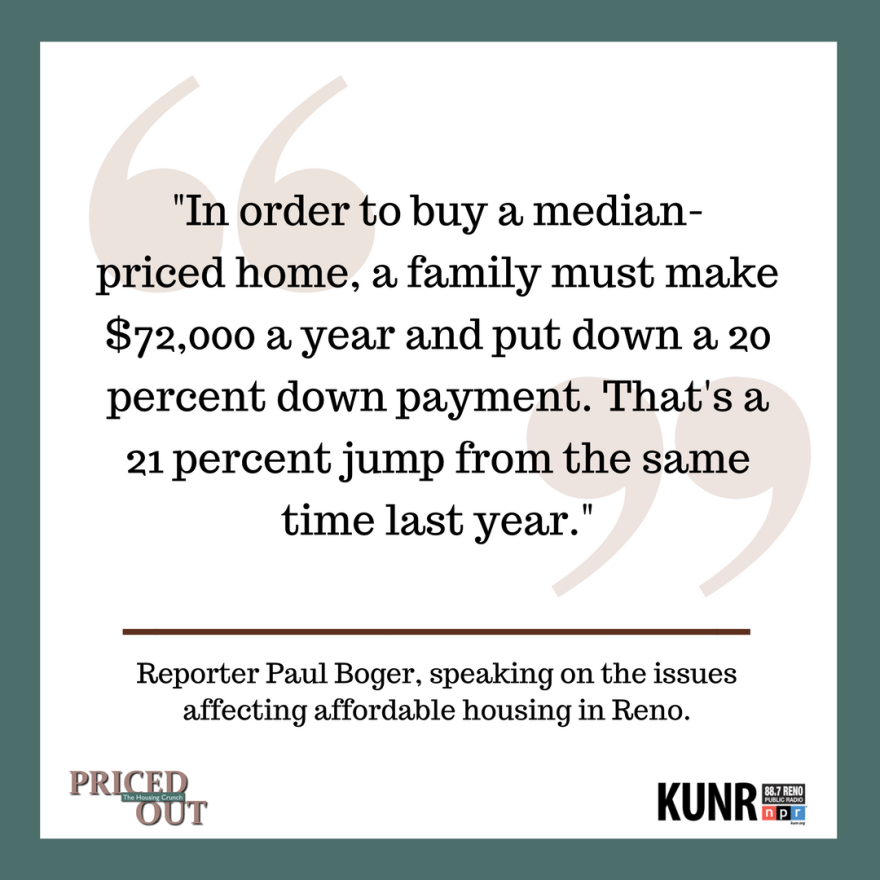We’ve all heard that Northern Nevada and Eastern California are facing a severe shortage of affordable housing, but what does that actually mean and how are people being affected? Over the next several weeks, KUNR is examining the issue from all angles in a series we’re calling Priced Out: The Housing Crunch.
So, let’s get right to it. Why is Northern Nevada in the midst of an affordable housing crunch?
Well, first and foremost, there’s simply not enough housing.
A lot of that is due to the fact that so many businesses are moving to the area.
Northern Nevada has been able to attract a lot of new businesses, most notably Tesla, Panasonic, Switch. That’s thousands of new jobs right there. Then there are the ancillary jobs that have been created by the sudden influx of those businesses, bringing more people.
Add that to the fact that the area has a relatively nice climate, low taxes, a growing arts and culture scene; more people just seem to want to live in Northwestern Nevada.
So it’s a supply and demand issue?
More people means more money means more jobs means greater demands on housing, right?
There has been a rather rapid influx of new residents and construction is just not keeping up with the demand.
One of the reasons that there is a dearth of construction is because of the Great Recession. In 2009, Nevada was hit hard. It had been the fastest growing state, and houses were springing up around the state. Just look at Fernley. At one point it was one of the fastest growing towns in the US, but when the market went belly up it became the foreclosure capital of the country. And with a glut of housing on the market, construction stopped and construction workers simply left.
But what do we mean by affordable? I mean, what might be affordable to you and me, might not be considered affordable to somebody else.
The federal government considers affordable as costing less than 30 percent of a family’s income. Any more than that and they’re considered cost burdened.
To put that in perspective, the National Realtor’s Association Numbers recently announced that the median price for a pre-existing, single-family home in Reno in $400,000.
In order to afford that home, a family must make at least $72,000 a year and have put down a 20 percent down payment. That’s a 21 percent jump from the same time last year. That’s higher than a number of Western cities, including Boise, Las Vegas, Phoenix, Sacramento, Riverside, Salt Lake City, Tucson, and Spokane. It’s also higher than major cities like Chicago, Philadelphia, Nashville, Dallas, Austin and Baltimore.
It’s also important to remember that these numbers are specifically for the Truckee Meadows. For areas outside the valley, like Fernley, Fallon, and Dayton, prices are lower. There are fewer people and less competition for land, but resources like water and healthcare are scarce, which in turn drives up prices. On top of it, they’re facing a housing shortage, which hinders their ability to attract new businesses.
For Tahoe – prices are higher. The problems there are exacerbated by the large number of second homes and vacation rental properties. It’s a problem KUNR actually looked at a couple years ago in a series called Squeezed Out that looks at affordable housing in Tahoe.
As for rentals, it’s not much better. Last year, Reno had the 4th largest spike in rental prices in the country, with prices averaging around $950 a month.
Is there a fix to the problem?
That’s the million dollar question, isn’t?
I don’t think there is any doubt that there is just a lack of homes. Whether it’s the traditional single-family unit or multi-family/high-density apartments, there’s just not enough of them.
So, city and state leaders need to come up with ways to incentivize more construction around Truckee Meadows.
There’s also the question about what to do with the area’s weekly motels. A lot of them are considered run down eyesores that pose public safety concerns, and yet, they play a vital role in keeping some of the area’s most vulnerable residents off the street. Meaning, if the weeklies go away, a lot of those folks are going to become homeless.
All of these issues play into the area’s affordable housing crunch. And over the course of the next few weeks, the KUNR newsroom will examine the issues from all sides in order for all of us to better understand how to fix the problem.







